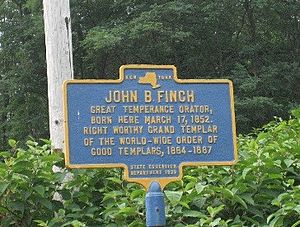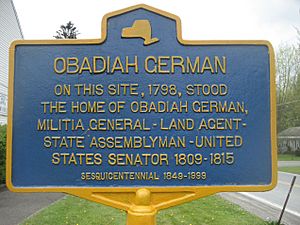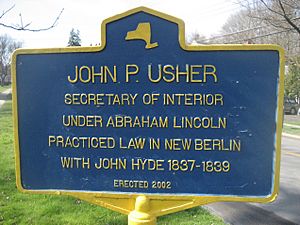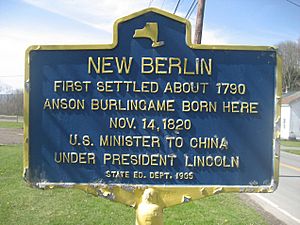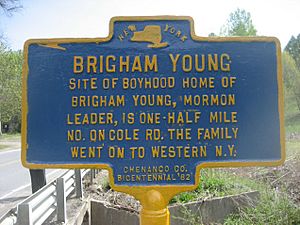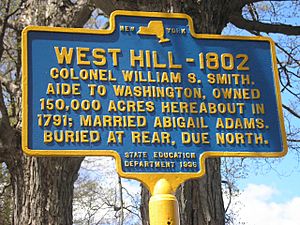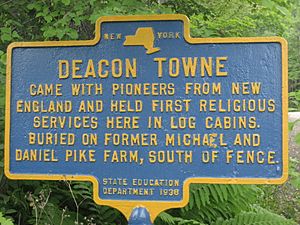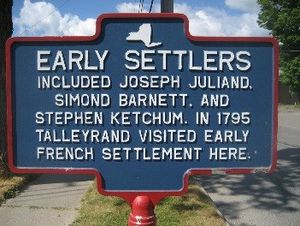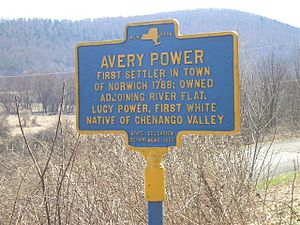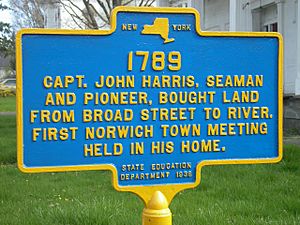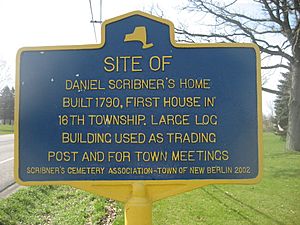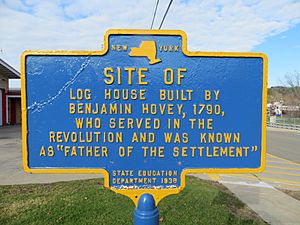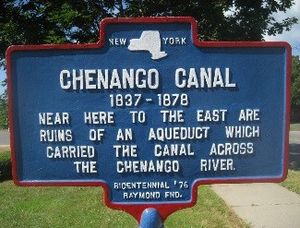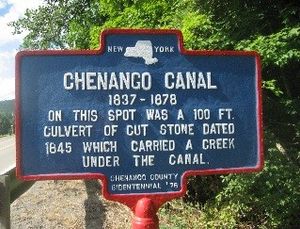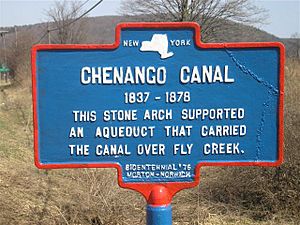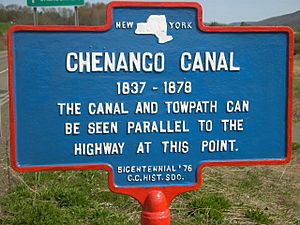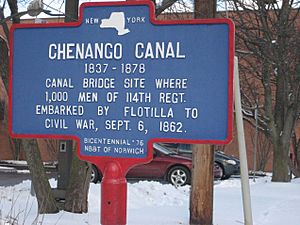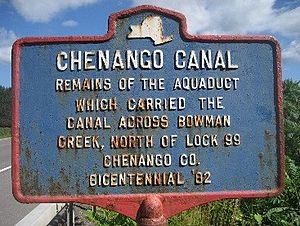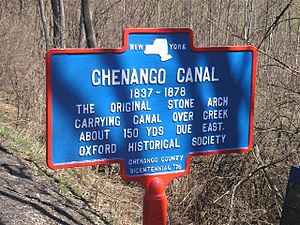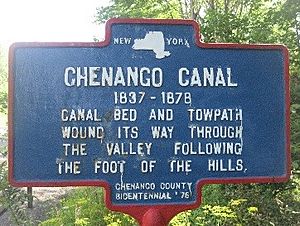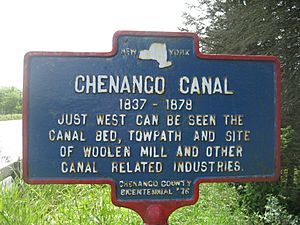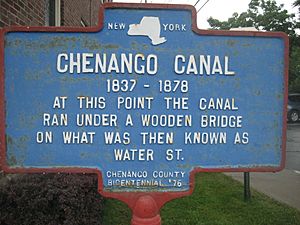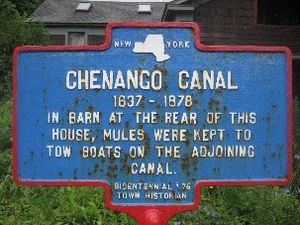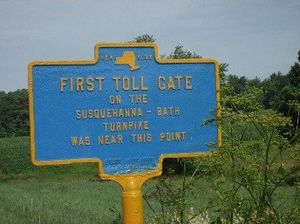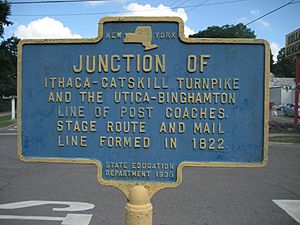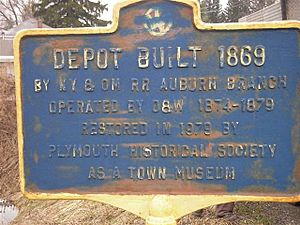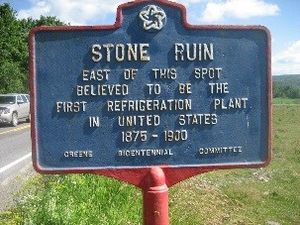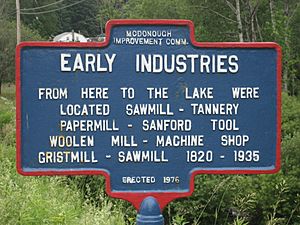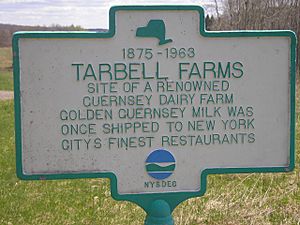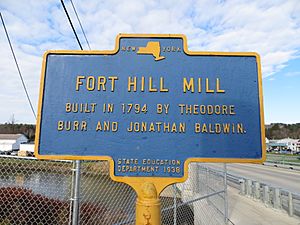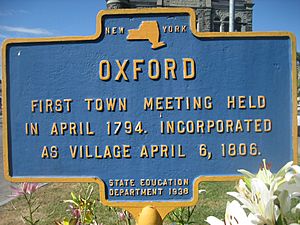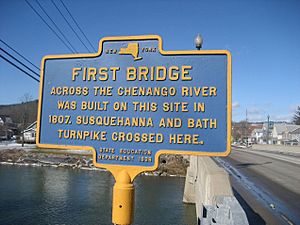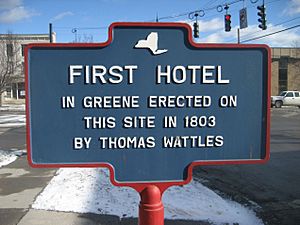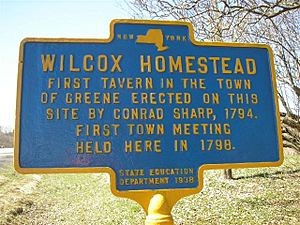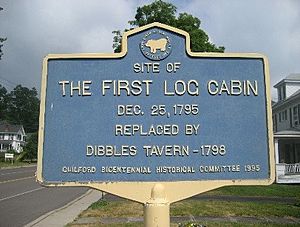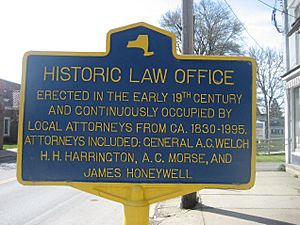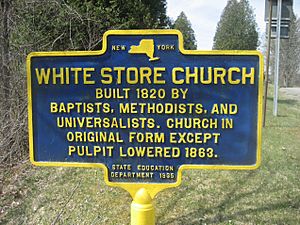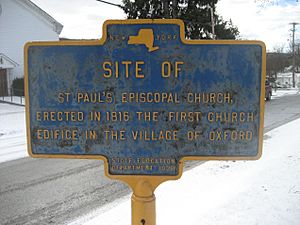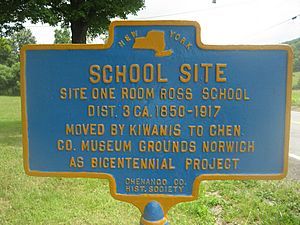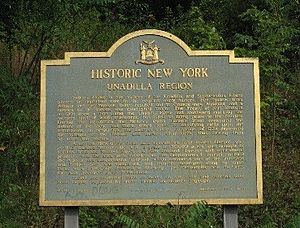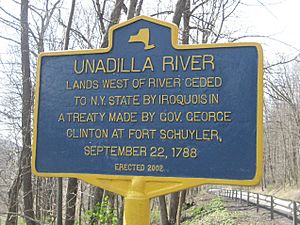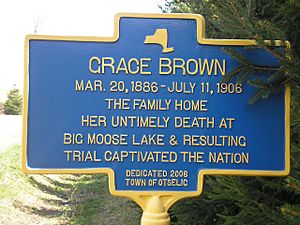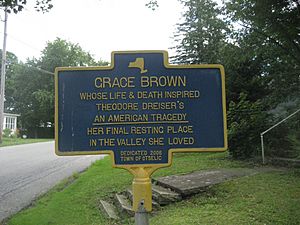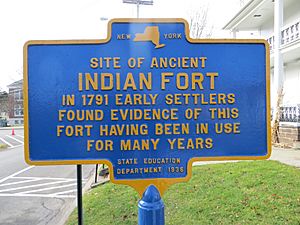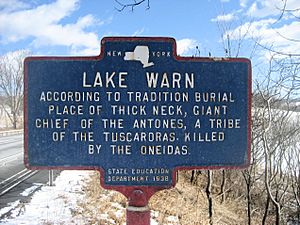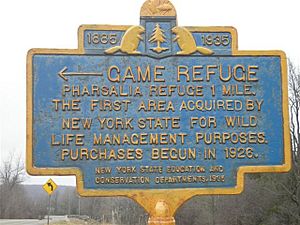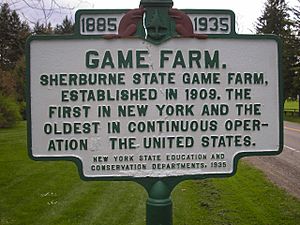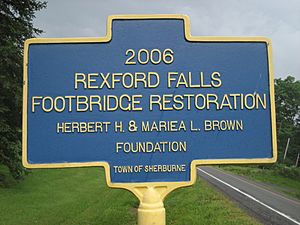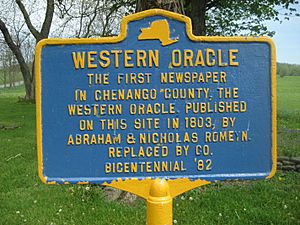List of New York State Historic Markers in Chenango County, New York facts for kids
Chenango County, located in the heart of New York State, is a place rich with history. All around the county, you can find special markers that tell stories about important people, places, and events from the past. These markers help us remember how life used to be and the big changes that shaped the area.
From early Native American life to the building of canals and the lives of famous figures, these markers are like outdoor history books. They invite you to explore and learn about the pioneers who settled here, the industries that grew, and the moments that made Chenango County what it is today.
Contents
- Historic People and Their Stories
- Leaders and Thinkers
- Early Settlers and Pioneers
- Deacon Towne: First Religious Services
- Joseph Juliand and Early French Settlement
- Stephen Ketchum's Log Cabin
- Avery Power: Norwich's First Settler
- Captain John Harris: A Seaman and Pioneer
- Colonel William Monroe: Revolutionary Drummer Boy
- Daniel Scribner's First Home
- Benjamin Hovey: Father of the Settlement
- Transportation and Industry
- The Chenango Canal
- Canal Inn and Repair Station
- Towpath and Canal Bed
- Aqueduct Ruins
- Culvert Under the Canal
- Aqueduct Over Fly Creek
- Meads Pond Holding Basin
- Canal and Towpath Parallel to Highway
- Norwich Canal Bridge and Civil War
- Aqueduct Over Bowman Creek
- Original Stone Arch
- Oxford Turning Basin
- Canal Bed and Towpath in the Valley
- Canal Industries in Sherburne
- Canal Under a Wooden Bridge
- Mules for Towing Boats
- Roads and Railways
- Early Industries
- The Chenango Canal
- Communities and Landmarks
- Town Origins
- Important Buildings and Sites
- First Church in Greene Village
- First Baptist Church in Chenango County
- First Bridge Over Chenango River
- First Hotel in Greene
- Wilcox Homestead: First Tavern and Town Meeting Site
- First Doctor's Office
- First Log Cabin in Guilford
- Historic Law Office in New Berlin
- St. Andrews Church and Cemetery
- White Store Church
- Congregational Church in Oxford
- First Site of Oxford Academy
- Baldwin Home: Builder of Early Oxford
- Site of St. Paul's Episcopal Church
- Preston Schoolhouse
- Natural Features and Other Sites
- Unadilla Region and Native Americans
- Carr Farm: Brant's Meeting Place
- Unadilla River: A Treaty Site
- Go-Won-Go Mohawk: An Indian Princess
- The Castle: Oneida Indian Fort
- Grace Brown: An American Tragedy
- Ancient Indian Fort in Oxford
- Lake Warn: Burial Place of a Giant Chief
- Pharsalia Game Refuge
- Sherburne Game Farm
- Rexford Falls Footbridge Restoration
- Western Oracle: Chenango County's First Newspaper
- Images for kids
Historic People and Their Stories
Chenango County has been home to many interesting people. Markers celebrate their lives and contributions.
Leaders and Thinkers
Joseph Smith's Marriage
In Afton, New York, there's a marker for the Mormon House. This house is where Joseph Smith, who founded the Mormon Church, married Emma Hale in 1827. It's a significant spot for understanding the early history of the church.
John B. Finch: A Champion for Change
Near Lincklaen, you can find a marker for John B. Finch. Born in 1852, he became a very famous speaker who worked to stop alcohol use. He was even a top leader for a worldwide group called the Order of Good Templars from 1884 to 1887.
Obadiah German: A Senator from Chenango
In North Norwich, a marker remembers Obadiah German. His home, built in 1798, stood on this spot. German was a very important person in early New York. He was a general in the militia, a land agent, a state assemblyman, and even a United States Senator from 1809 to 1815.
John P. Usher: Lincoln's Secretary
In New Berlin, a marker honors John P. Usher. He was a lawyer in New Berlin from 1837 to 1839. Later, he became the Secretary of the Interior under President Abraham Lincoln. This shows how people from Chenango County could reach high positions in government.
Anson Burlingame: Diplomat from New Berlin
Another important figure from New Berlin is Anson Burlingame, born around 1820. He became a U.S. Minister, which is like an ambassador, under President Lincoln. He played a key role in foreign relations.
Ruth Benedict: A Pioneer Anthropologist
South of Norwich, a marker points to the childhood home of Dr. Ruth Benedict. Born in 1887, she became one of the first well-known women anthropologists. She wrote a famous book called "Patterns of Culture."
Brigham Young's Boyhood Home
In Smyrna, a marker shows the site of the boyhood home of Brigham Young. He was a very important leader of the Mormon Church. His family later moved to Western New York.
Colonel William S. Smith: Washington's Aide
Near Sherburne, the West Hill marker tells us about Colonel William S. Smith. He was an aide to George Washington during the American Revolution. In 1791, he owned a huge amount of land (150,000 acres) in this area. He was also married to Abigail Adams, the daughter of President John Adams. He is buried nearby.
Early Settlers and Pioneers
Deacon Towne: First Religious Services
In McDonough, a marker for Deacon Towne tells us about one of the first pioneers. He came from New England and held the first religious services in log cabins in the area. He is buried on what used to be the Michael and Daniel Pike Farm.
Joseph Juliand and Early French Settlement
In Greene, a marker for Early Settlers mentions Joseph Juliand, Simon Barnett, and Stephen Ketchum. Interestingly, in 1795, a famous French diplomat named Talleyrand visited an early French settlement here.
Stephen Ketchum's Log Cabin
Another marker in Greene focuses on Stephen Ketchum. He settled near this spot and built his log cabin in 1792. This was one of the very first homes in the area.
Avery Power: Norwich's First Settler
South of Norwich, a marker for Avery Power highlights the first settler in Norwich in 1788. He owned the land along the river. His daughter, Lucy Power, was the first white child born in the Chenango Valley.
Captain John Harris: A Seaman and Pioneer
In Norwich, a marker from 1789 tells us about Captain John Harris. He was a seaman and pioneer who bought land from Broad Street to the river. The very first town meeting in Norwich was held in his home.
Colonel William Monroe: Revolutionary Drummer Boy
Also in Norwich, a marker for the First Log Cabin points to the spot where Colonel William Monroe built his cabin around 1790. He was known as the "Drummer Boy of the Revolutionary War."
Daniel Scribner's First Home
Two miles south of New Berlin, a marker shows the Site of Daniel Scribner's Home. Built in 1790, it was the very first house in the 16th Township. This large log building was used as a trading post and for town meetings.
Benjamin Hovey: Father of the Settlement
In Oxford, a marker marks the Site of Log House built by Benjamin Hovey in 1790. He served in the American Revolution and was known as the "Father of the Settlement" because of his important role in establishing the community.
Transportation and Industry
Transportation and industry were key to Chenango County's growth.
The Chenango Canal
The Chenango Canal was a huge project built between 1837 and 1878. It connected the area to Utica and Binghamton, helping transport goods and people. Many markers throughout the county tell its story.
Canal Inn and Repair Station
In Greene, a marker for Chenango Canal #16 shows a historic building that was an inn for canal travelers from 1846 to 1856. A canal boat repair station was also located nearby.
Towpath and Canal Bed
Another marker in Greene, Chenango Canal #17, highlights where the canal bed and towpath curved to create a level route along the valley floor.
Aqueduct Ruins
Near Greene, Chenango Canal #19 marks the ruins of an aqueduct that carried the canal across the Chenango River. Aqueducts were like bridges for water, allowing the canal to cross rivers or valleys.
Culvert Under the Canal
In Greene, Chenango Canal #20 points to a spot where a 100-foot stone culvert, built in 1845, carried a creek under the canal. This was an impressive engineering feat.
Aqueduct Over Fly Creek
In North Norwich, Chenango Canal #5 marks a stone arch that supported an aqueduct. This structure carried the canal over Fly Creek.
Meads Pond Holding Basin
Also in North Norwich, Chenango Canal #6 tells us that Meads Pond was used as a "holding basin." This means it stored water for barges carrying iron, coal, and other goods on the canal.
Canal and Towpath Parallel to Highway
In North Norwich, Chenango Canal #7 indicates a spot where you can still see the canal and its towpath running alongside the highway.
Norwich Canal Bridge and Civil War
In Norwich, Chenango Canal #9 marks the site of a canal bridge. This was a very important spot because, on September 6, 1862, 1,000 men of the 114th New York Regiment left by boat (flotilla) from here to fight in the Civil War.
Aqueduct Over Bowman Creek
In Oxford, Chenango Canal #15 shows the remains of an aqueduct that carried the canal across Bowman Creek, just north of Lock 99.
Original Stone Arch
Another Oxford marker, Chenango Canal #13, points to an original stone arch that carried the canal over a creek about 150 yards to the east.
Oxford Turning Basin
In Oxford, Chenango Canal #14 marks the site of the Oxford turning basin. This was a place where canal boats could tie up overnight.
Canal Bed and Towpath in the Valley
Still in Oxford, Chenango Canal #15 (another one with the same number, but a different image) shows how the canal bed and towpath wound their way through the valley, following the hills.
Canal Industries in Sherburne
In Sherburne, Chenango Canal #2 points to the west where you can see the canal bed, towpath, and the site of a woolen mill and other businesses that relied on the canal.
Canal Under a Wooden Bridge
In Sherburne, Chenango Canal #3 marks the spot where the canal ran under a wooden bridge on what was then called Water Street.
Mules for Towing Boats
Also in Sherburne, Chenango Canal #4 tells us that in a barn behind a nearby house, mules were kept to tow boats on the canal. Mules were essential for pulling the heavy barges.
Roads and Railways
First Toll Gate
Near Bainbridge, a marker for the First Toll Gate tells us that a toll gate for the Susquehanna-Bath Turnpike was located near this point. Turnpikes were early roads where you had to pay a fee (a toll) to use them.
Ithaca-Catskill Turnpike Junction
In Oxford, a marker shows the Junction of Ithaca-Catskill Turnpike. This was an important crossroads where the Ithaca-Catskill turnpike met the Utica-Binghamton line of Post Coaches. This stagecoach and mail route started in 1822.
NYO&W Depot: A Busy Railroad Hub
In New Berlin, the N.Y.O.&.W. Depot marker highlights a large train station built in 1869. It was the biggest depot built by the New York, Oswego Midland and R.R. Its size shows how important New Berlin was to the railroad.
O&W Railroad Yards in Norwich
In Norwich, a marker for Railroad Yards shows where the Northern Division Offices, yards, and repair shops of the New York, Ontario & Western Railway were located from 1868 to 1957. This was a major center for the railroad.
Lyon Brook Bridge: An Engineering Marvel
Between Norwich and Oxford, the Lyon Brook Bridge marker tells about an impressive railroad bridge. Built in 1869 by the New York & Oswego Midland Railroad, it was 1,200 feet long and 156 feet high! The site is about half a mile east of the marker.
Plymouth Depot: A Town Museum
In Plymouth, the Depot Built 1869 marker points to a train station built by the NY & OM Railroad. It was later operated by the O&W Railroad. In 1979, the Plymouth Historical Society restored it to be used as a Town Museum.
Albany-Ithaca Turnpike: A Milestone Marker
In Smyrna, the Albany-Ithaca Turnpike 100 marker shows where a stake was driven to mark 100 miles west from Albany on the Albany-Ithaca Turnpike, which was built in 1805. This was an important early road.
Early Industries
First Refrigerator Plant
In Greene, a marker for the First Refrigerator Plant suggests that east of this spot was likely the first refrigeration plant in the United States, operating from 1875 to 1900. This was a very early step in keeping food cold!
McDonough's Early Industries
In McDonough, the Early Industry marker lists many businesses that operated from 1820 to 1935. These included sawmills, a tannery, a papermill, a woolen mill, a machine shop, and a grist mill. This shows how busy and productive the area was.
Tarbell Farms: Famous Dairy Farm
In Smithville, the Tarbell Farms marker tells the story of a famous Guernsey Dairy Farm that operated from 1875 to 1963. Their "Golden Guernsey" milk was even shipped to fancy restaurants in New York City!
Fort Hill Mill
In Oxford, the Fort Hill Mill marker points to a mill built in 1794 by Theodore Burr and Jonathan Baldwin. Mills were essential for grinding grain and processing other goods in early settlements.
Communities and Landmarks
Markers also highlight the founding of towns, important buildings, and natural features.
Town Origins
Greene: From Hornby to Greene
In Greene, a marker simply named Greene explains that the village was planned out in 1806 by Elisha Smith. It was first called Hornby, but later renamed after General Nathaniel Greene. It officially became a village in 1842.
McDonough: Named for a Commodore
A marker for the Town of McDonough explains that the town was created from the Town of Preston on April 17, 1816. It was named after Commodore Thomas MacDonough, a naval hero from 1783 to 1825.
Oxford: First Town Meeting
In Oxford, a marker for Oxford states that the first town meeting was held in April 1794. The village was officially incorporated on April 6, 1806.
Important Buildings and Sites
First Church in Greene Village
In Greene, a marker for the First Church in Village of Greene tells us about the Congregational Church, which was organized in 1811. The first pastor was Rev. John B. Hoyt.
First Baptist Church in Chenango County
Also in Greene, the First Baptist Church marker notes that this church was organized on this site in 1795 by Elder Nathaniel Kellogg. It was the first Baptist church in Chenango County.
First Bridge Over Chenango River
In Greene, a marker for the First Bridge indicates the spot where the first bridge across the Chenango River was built in 1807. The Susquehanna and Bath Turnpike also crossed here.
First Hotel in Greene
In Greene, the First Hotel marker shows where the first hotel in Greene was built in 1803 by Thomas Wattles.
Wilcox Homestead: First Tavern and Town Meeting Site
North of Greene, the Wilcox Homestead marker points to the site of the first tavern in the Town of Greene, built by Conrad Sharp in 1794. The first Town Meeting was also held here in 1798.
First Doctor's Office
In Guilford, the First Doctor marker shows the site of the first office and home of Dr. John Clark, the first doctor in Guilford.
First Log Cabin in Guilford
Also in Guilford, a marker for the First Log Cabin indicates the site of the very first log cabin, built on December 25, 1795. It was later replaced by Dibbles Tavern in 1798.
Historic Law Office in New Berlin
In New Berlin, the Historic Law Office marker highlights a building erected in the early 1800s. It was continuously used by local lawyers from about 1830 to 1995, including famous ones like General A.C. Welch.
St. Andrews Church and Cemetery
In New Berlin, the St. Andrews Church and Cemetery marker tells us that worship began here in 1808, led by Father Daniel Nash. It was the first Episcopal Church in Chenango County, and the cemetery is owned by the church.
White Store Church
In Norwich, the White Store Church marker describes a church built in 1820 by Baptists, Methodists, and Universalists. The church still looks much like it did originally, except the pulpit was lowered in 1863.
Congregational Church in Oxford
In Oxford, the Congregational Church marker points to the oldest church building still standing in the village. It was dedicated on July 31, 1823.
First Site of Oxford Academy
In Oxford, a marker for the First Site of Oxford Academy notes that its charter was granted in 1794. Uri Tracy was the first principal. It was one of the first four schools to receive a charter west of the Hudson River, making it very important for early education.
Baldwin Home: Builder of Early Oxford
In Oxford, the Baldwin Home marker shows the site of a home built by Jonathan Baldwin in 1794. He was a busy builder, responsible for the first school, many houses, and the second river bridge in Oxford.
Site of St. Paul's Episcopal Church
In Oxford, a marker for the Site of St. Paul's Episcopal Church indicates where the first church building in the village was erected in 1816.
Preston Schoolhouse
In Preston, the School Site marker shows where a one-room schoolhouse, Ross School District 3, stood from about 1850 to 1917. It was later moved to the Chenango County Museum Grounds in Norwich.
Natural Features and Other Sites
Unadilla Region and Native Americans
Near Afton, a marker for Historic New York, Unadilla Region explains that Native Americans living in the valleys of the Unadilla and Susquehanna Rivers played a big part in the early history of this region.
Carr Farm: Brant's Meeting Place
In Columbus, a marker for Arrow (Carr Farm) points to a spot a quarter mile away. This was the historic Carr Farm, a meeting place for Brant's Native American warriors and Tories (people loyal to the British) from 1770 to 1778.
Unadilla River: A Treaty Site
In Columbus, a marker for the Unadilla River notes that the lands west of the river were given to New York State by the Iroquois people in a treaty. This treaty was made by Governor George Clinton at Fort Schuyler on September 22, 1778.
Go-Won-Go Mohawk: An Indian Princess
In Greene, a marker for Go-Won-Go Mohawk tells us that an Indian princess lived in the house at this spot.
The Castle: Oneida Indian Fort
South of Norwich, a marker for The Castle indicates a spot a quarter mile west. This was an Oneida Indian Fort where councils were held until 1790.
Grace Brown: An American Tragedy
In Otselic, two markers remember Grace Brown, born in 1886. Her untimely death in 1906 and the trial that followed captivated the nation. Her story inspired Theodore Dreiser's famous book, "An American Tragedy." One marker is at her family home, and another is near her final resting place in the valley she loved.
Ancient Indian Fort in Oxford
In Oxford, a marker for the Site of Ancient Indian Fort explains that in 1791, early settlers found evidence that this fort had been used by Native Americans for many years.
Lake Warn: Burial Place of a Giant Chief
Between Brisben and Oxford, the Lake Warn marker shares a local tradition. It says that Lake Warn is the burial place of Thick Neck, a giant Chief of the Antones, a tribe of the Tuscaroras, who was killed by the Oneidas.
Pharsalia Game Refuge
In Pharsalia, a marker for Game Refuge tells us about the Pharsalia Refuge, which is one mile away. This was the first area bought by New York State for wildlife management, with purchases starting in 1926.
Sherburne Game Farm
In Sherburne, a marker for Game Farm highlights the Sherburne State Game Farm. Established in 1909, it was the first of its kind in New York and the oldest still operating continuously in the state.
Rexford Falls Footbridge Restoration
In Sherburne, a marker for Rexford Falls notes the restoration of a footbridge in 2006, supported by the Herbert H. & Mariea L. Brown Foundation.
Western Oracle: Chenango County's First Newspaper
In Sherburne, the Western Oracle marker tells us that the first newspaper in Chenango County was published on this site in 1803 by Abraham and Nicholas Romeyn.
Images for kids



